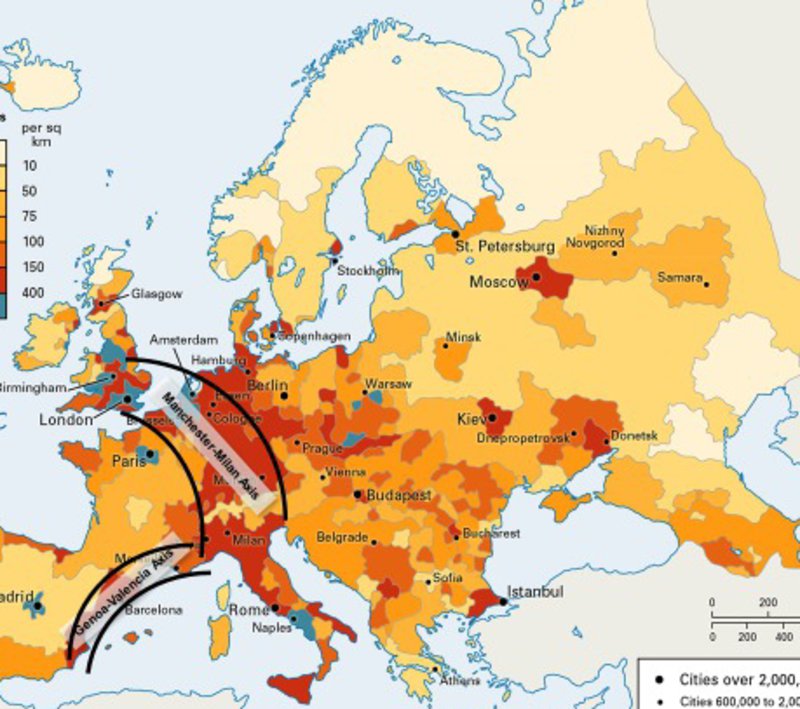Geography and the Catalan conflict
In the early 21st century, several popular authors espoused the view that today’s unprecedentedly cheap and fast communications would act as a global equaliser, allowing companies located anywhere in the world to compete on a level playing field.
They failed to see that, when distance matters less, scale and integration matter more – for, if transportation costs are low, it makes sense to concentrate production in a single, highly-productive “hub” and serve the world from there. Thus, technological progress leads markets to reorganise around high-producing “core” regions surrounded by peripheries with low-synergy and more cost-sensitive activities (agriculture, low-tech manufacturing), and others based on local natural resource advantages (mining, tourism). Core regions are easy to spot: Europe’s main “core” is the region (variously known as “European Backbone” or “Manchester-Milan Axis”) stretching from Lombardy to England and centred on the Rhine-Ruhr area, Germany’s largest metropolis and industrial heartland.
Europe’s core economic areas
Core and periphery dynamics are different. In the core, higher productivity fosters higher salaries. When things go well, investment in the core aims primarily at enhancing productivity (say, R&D), whereas the periphery focuses on capturing additional rents (e.g. tourist property). Then, when a recession hits, periphery workers may become too expensive and lose their jobs, whereas higher productivity often protects the income of those at the core.
Exceptions exist: the Asian “Tigers” (South Korea, Taiwan, Singapore) or the European ones (Ireland, the Baltic Republics) attracted high-value-added industries by liberalising and removing privileges without losing (actually strengthening) their welfare states. Yet, this requires opposing precisely those who enjoy existing privileges and have the power to defend them. Thus, missed opportunities abound. In 1990, the Irish, Greek and Portuguese had similar average incomes; today, Ireland’s income per capita more than doubles Portugal’s or Greece’s. Catalonia faces a similar crossroads. Spain’s EU integration greatly enhanced its income and welfare, but also made its economy more peripheral. Meanwhile Catalonia, historically Spain’s industrial powerhouse and still a major manufacturing hub, found itself at the centre of a fast-growing region (the “Genoa-Valencia Axis”) expanding the Manchester-Milan Axis as its natural access to the Mediterranean. Between 2009 and 2017, Catalonia’s total factor productivity grew at over twice the rate of the rest of Spain, while Catalan goods sales to the rest of Spain, which 20 years ago represented two thirds of exports, now amount to a third of them. Spain’s population is concentrated on the Mediterranean coast, while the rest of the country depopulates, with one exception: Madrid, which thrives through (often mandatory) services it sells to the rest of Spain as its seat of government and major companies’ headquarters. Left to its own devices, however, Barcelona might grow enough as the centre of the “Genoa-Valencia Axis” to eventually become Iberia’s business capital.
This challenges Spain’s power balance. Before EU integration, Spain was Catalonia’s main market, and its government enforced the tariffs and managed the devaluations that protected it from foreign competitors. Yet this mutual dependency is gone. Thus, perhaps predictably, not long after joining the euro zone, Spain’s establishment started limiting Catalonia’s prospects through government intervention: limiting Catalan financial autonomy, spending on unnecessary infrastructure elsewhere while those in Catalonia fall apart, enticing and subsidising companies to move from Catalonia to Madrid, even actively blocking EU-financed investments in Catalonia… As it became obvious the State was unwilling to negotiate reverting these policies, between 2007 and 2014 support for Catalan independence soared from 15% to over 50%, particularly among the educated middle classes. Indeed, their demonstrated capacity for meticulously organised, scrupulously peaceful mobilisation befits this background, while their massive numbers and willingness to withstand violent repression bear witness to their deep concern – for there is much at stake.

